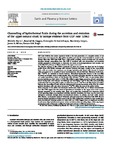Channelling of hydrothermal fluids during the accretion and evolution of the upper oceanic crust: Sr isotope evidence from ODP Hole 1256D
| dc.contributor.author | Harris, Michelle | |
| dc.contributor.author | Coggon, RM | |
| dc.contributor.author | Smith-Duque, CE | |
| dc.contributor.author | Cooper, MJ | |
| dc.contributor.author | Milton, JA | |
| dc.contributor.author | Teagle, DAH | |
| dc.date.accessioned | 2015-08-18T09:01:04Z | |
| dc.date.available | 2015-08-18T09:01:04Z | |
| dc.date.issued | 2015-04 | |
| dc.identifier.issn | 0012-821X | |
| dc.identifier.issn | 1385-013X | |
| dc.identifier.uri | http://hdl.handle.net/10026.1/3524 | |
| dc.description.abstract |
ODP Hole 1256D in the eastern equatorial Pacific is the first penetration of a complete section of fast spread ocean crust down to the dike-gabbro transition, and only the second borehole to sample in situ sheeted dikes after DSDP Hole 504B. Here a high spatial resolution record of whole rock and mineral strontium isotopic compositions from Site 1256 is combined with core observations and downhole wireline geophysical measurements to determine the extent of basalt-hydrothermal fluid reaction and to identify fluid pathways at different levels in the upper ocean crust.The volcanic sequence at Site 1256 is dominated by sheet and massive lava flows but the Sr isotope profile shows only limited exchange with seawater. However, the upper margins of two anomalously thick (>25 m) massive flow sequences are strongly hydrothermally altered with elevated Sr isotope ratios and appear to be conduits of lateral low-temperature off-axis fluid flow. Elsewhere in the lavas, high 87Sr/86Sr are restricted to breccia horizons. Mineralised hyaloclastic breccias in the Lava-Dike Transition are strongly altered to Mg-saponite, silica and pyrite, indicating alteration by mixed seawater and cooled hydrothermal fluids. In the Sheeted Dike Complex 87Sr/86Sr ratios are pervasively shifted towards hydrothermal fluid values (~0.705). Dike chilled margins display secondary mineral assemblages formed during both axial recharge and discharge and have higher 87Sr/86Sr than dike cores, indicating preferential fluid flow along dike margins. Localised increases in 87Sr/86Sr in the Dike-Gabbro Transition indicates the channelling of fluids along the sub-horizontal intrusive boundaries of the 25 to 50 m-thick gabbroic intrusions, with only minor increases in 87Sr/86Sr within the cores of the gabbro bodies.When compared to the pillow lava-dominated section from Hole 504B, the Sr isotope measurements from Site 1256 suggest that the extent of hydrothermal circulation in the upper ocean crust may be strongly dependent on the eruption style. Sheet and massive flow dominated lava sequences typical of fast spreading ridges may experience relatively restricted circulation, but there may be much more widespread circulation through pillow lava-dominated sections. In addition, the Hole 1256D sheeted dikes display a much greater extent of Sr-isotopic exchange compared to dikes from Hole 504B. Because seawater-derived hydrothermal fluids must transit the dikes during their evolution to black smoker-type fluids, the different Sr-isotope profiles for Holes 504B and 1256D suggest there are significant variations in mid-ocean ridge hydrothermal systems at fast and intermediate spreading ridges, which may impact geochemical cycles of elements mobilised by fluid-rock exchange at different temperatures. | |
| dc.format.extent | 56-66 | |
| dc.language | en | |
| dc.language.iso | en | |
| dc.publisher | Elsevier BV | |
| dc.subject | mid-ocean ridge | |
| dc.subject | IODP | |
| dc.subject | hydrothermal circulation | |
| dc.subject | fluid-rock reaction | |
| dc.subject | Sr isotopes | |
| dc.subject | fluid channelling | |
| dc.title | Channelling of hydrothermal fluids during the accretion and evolution of the upper oceanic crust: Sr isotope evidence from ODP Hole 1256D | |
| dc.type | journal-article | |
| dc.type | Journal Article | |
| plymouth.author-url | https://www.webofscience.com/api/gateway?GWVersion=2&SrcApp=PARTNER_APP&SrcAuth=LinksAMR&KeyUT=WOS:000351811400006&DestLinkType=FullRecord&DestApp=ALL_WOS&UsrCustomerID=11bb513d99f797142bcfeffcc58ea008 | |
| plymouth.volume | 416 | |
| plymouth.publication-status | Published | |
| plymouth.journal | Earth and Planetary Science Letters | |
| dc.identifier.doi | 10.1016/j.epsl.2015.01.042 | |
| plymouth.organisational-group | /Plymouth | |
| plymouth.organisational-group | /Plymouth/Faculty of Science and Engineering | |
| plymouth.organisational-group | /Plymouth/Faculty of Science and Engineering/School of Geography, Earth and Environmental Sciences | |
| plymouth.organisational-group | /Plymouth/REF 2021 Researchers by UoA | |
| plymouth.organisational-group | /Plymouth/REF 2021 Researchers by UoA/UoA07 Earth Systems and Environmental Sciences | |
| plymouth.organisational-group | /Plymouth/Users by role | |
| plymouth.organisational-group | /Plymouth/Users by role/Academics | |
| plymouth.organisational-group | /Plymouth/Users by role/Researchers in ResearchFish submission | |
| dc.identifier.eissn | 1385-013X | |
| dc.rights.embargoperiod | Not known | |
| rioxxterms.funder | Natural Environment Research Council | |
| rioxxterms.identifier.project | Dating mineral formation during mid-ocean ridge flank hydrothermal circulation: Evidence from the Juan de Fuca Ridge, IODP Expedition 327 | |
| rioxxterms.versionofrecord | 10.1016/j.epsl.2015.01.042 | |
| rioxxterms.licenseref.uri | http://www.rioxx.net/licenses/all-rights-reserved | |
| rioxxterms.type | Journal Article/Review | |
| plymouth.funder | Dating mineral formation during mid-ocean ridge flank hydrothermal circulation: Evidence from the Juan de Fuca Ridge, IODP Expedition 327::Natural Environment Research Council | |
| plymouth.funder | Dating mineral formation during mid-ocean ridge flank hydrothermal circulation: Evidence from the Juan de Fuca Ridge, IODP Expedition 327::Natural Environment Research Council | |
| plymouth.funder | Dating mineral formation during mid-ocean ridge flank hydrothermal circulation: Evidence from the Juan de Fuca Ridge, IODP Expedition 327::Natural Environment Research Council |


